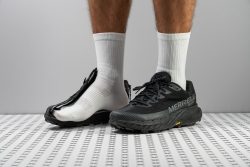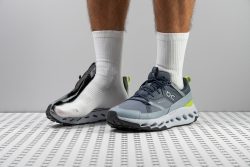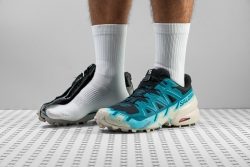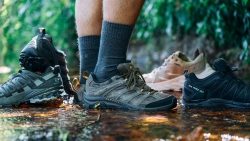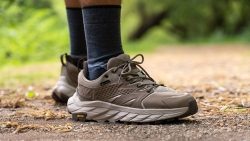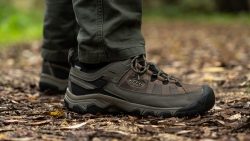4 Best Lightweight Waterproof Hiking Shoes in 2025

We buy shoes ourselves. We earn commissions when you buy through us, at no extra cost. Why trust us
Investing in a pair of high-quality waterproof shoes is one of the wisest things you can do for your feet. Whether you’re a seasoned outdoorsy person or a casual weekend warrior, you need to have the right gear when going on hiking trips with your family and friends.
For this guide, we’ve vetted lightweight, waterproof hiking shoes from different brands and carefully tested them on a variety of muddy terrains and H2O hiking adventures.
With tons of options available, getting the perfect pair can be time-consuming. To narrow down your best choices, we’ve ranked all the lightweight waterproof hiking shoes in our inventory. Read on to see our top recommendations in specific categories.
How we test lightweight waterproof hiking shoes
Each model on the list is methodically analyzed and tested on the trails. We carefully examine the quality of materials built into the footwear and determine how they actually perform during hiking activities. Here’s exactly what we do:
- We buy the lightweight waterproof hiking kicks with our own money. This is to guarantee our 100% impartiality when publishing our reviews.
- We hike with each pair multiple times, which allows us to assess the shoe's fit, shock absorption, waterproof capability, durability, breathability, and grip.
- We take the shoes to the lab where we test their flexibility, breathability, stiffness, and traction and measure all the details like stack heights, shock absorption, and lug depth. We even turn on our saw machine to cut the shoes in half and uncover everything. It's interesting to see the waterproof layer, its thickness, color, and how it makes the shoe less breathable.
Best lightweight waterproof hiking shoes overall
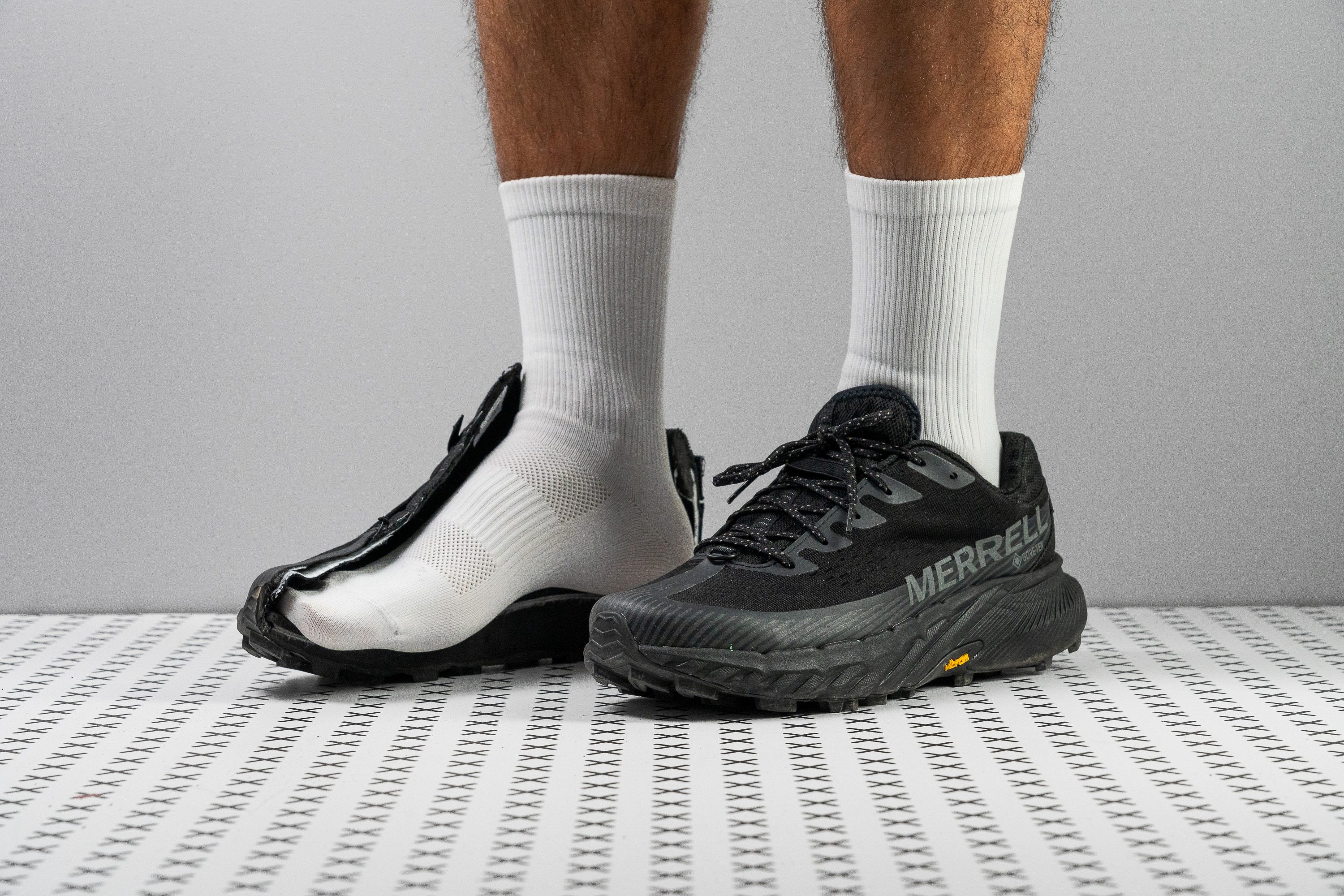













































What makes it the best?
After logging miles on foot and hours in the lab, we think the Merrell Agility Peak 5 GTX is aptly named because it packs so much protection in its lightweight and agile build. It’s easy to maneuver and gives us the confidence to explore new trails with its top-to-bottom shield. It essentially feels like a trail running pair, making it our top lightweight waterproof hiking shoe.
Our scales backed up the lightness we experienced, showing the AP5 GTX is only 10.4 oz (296g), 22.1% below average. It felt easy to adapt to various terrains because the midsole follows our feet at the snap of a finger. In our bend test, it emerged 5.9% more flexible than average.
Moving to the midsole, we found generous cushioning reaching a 37.3/25.7 mm stack height. Moreover, it features a rock plate for added defense against potential hazards.
We observed the Gore-Tex material in the upper, which effectively keeps our feet dry during wet encounters. In the lab, the smoke we pumped in couldn’t really escape, so we awarded it the lowest 1/5 breathability score–that’s good news for waterproof shoes!
However, the outsole lacks wear resistance for abrasive pavements or rugged terrain. Those seeking longevity or a road-to-trail shoe should try alternatives.
Pros
- True waterproof protection
- Grippy, trail-ready Vibram outsole
- Perfect for cold, wet climates
- Can handle some challenging conditions
- Stable yet cushioned heel
- Improved for hiking and walking
- Well-designed outsole lugs
- Great build quality
- Keeps feet warm
- Rock plate
Cons
- Narrow toebox
- Heel padding durability concerns
- No reflective elements
- Drop differs too much from stated
Lightweight waterproof hiking shoes with the best shock absorption
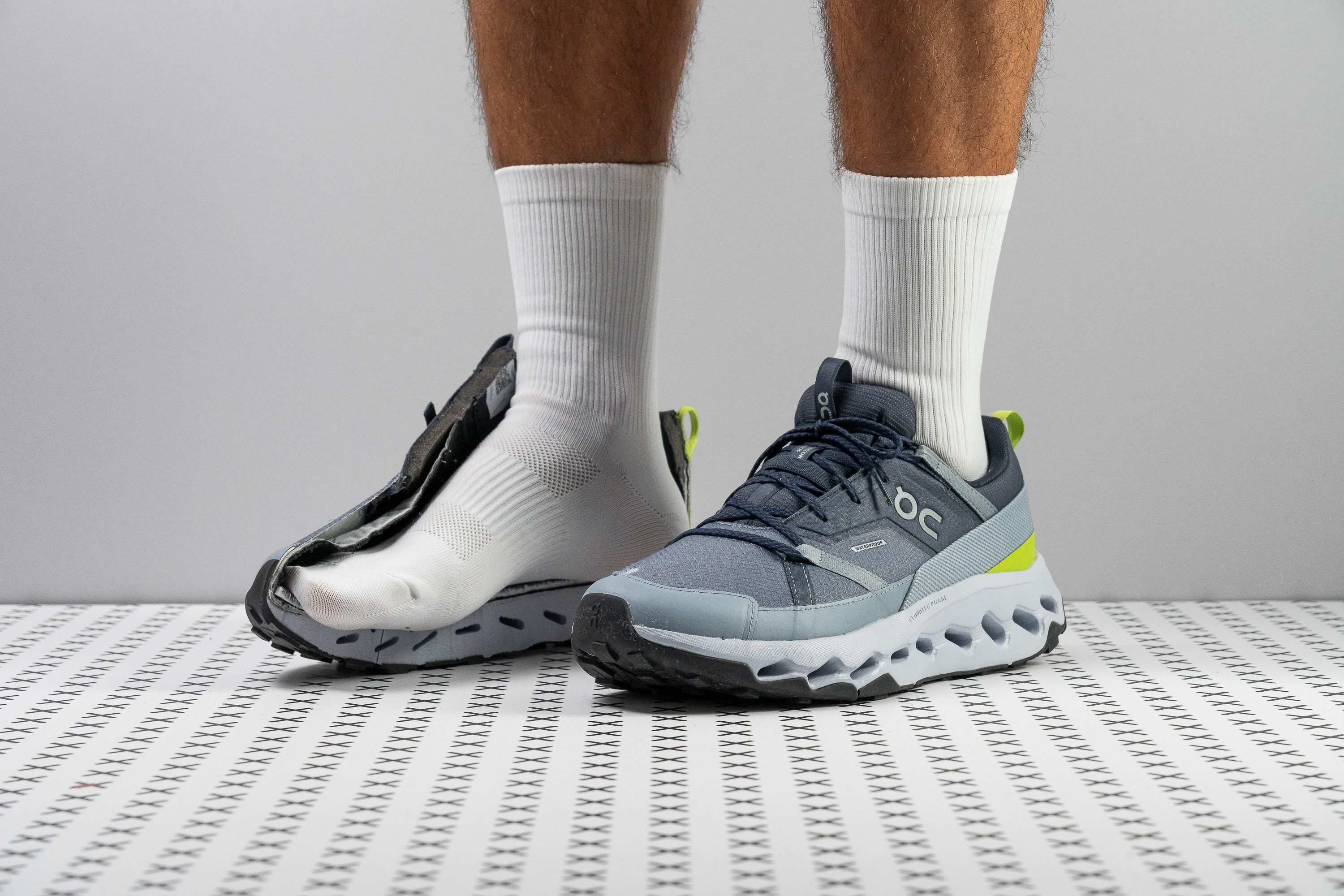




















































What makes it the best?
Supreme comfort, confident strides, and all-around protection are the main features of the On Cloudhorizon Waterproof. A mix of outdoor hikes and lab analysis reveals it leads the shock absorption category among lightweight waterproof hiking shoes we’ve tested—perfect for long days out on the trail.
As soon as we wore the shoe, its abundant cushioning was hard to ignore. We felt elevated from the ground, muting out any harsh rocks and roots underfoot. Our measurements confirm an above-average 39.4/29.2 mm stack. Topping it off, we recorded its capacity to absorb ground forces to be 20.0% better than average.
To our delight, this cozy cruiser feels really light and stable! Cloudhorizon only weighs 12.0 (339g) and enhances support through its rigidity and massive base. Its 116.3/89.1 mm base secured our footing while the midsole resisted ankle twists, proven by its high 4/5 torsional rigidity rating.
We splashed through rain puddles and streams, and our feet remained warm and dry, proving the upper’s impermeability. Not a wisp of smoke escaped the shoe in our smoke test, earning a 1/5 breathability score.
However, we recommend reserving this pair for light hikes. It’s hard to trust its shallow 2.3 mm lugs to grip through technical trails.
Pros
- Effective waterproofing
- Abundant cushioning and impact protection
- Lively and responsive ride
- Amazingly light for its stack and waterproofing
- Great as a city-to-trail shoe
- Good stability for moderate terrain
- Comfortable in-shoe feel
- True to size and fit
Cons
- Not for serious hiking
- Lacks durabiity for the price
Lightweight waterproof shoes with the best stability
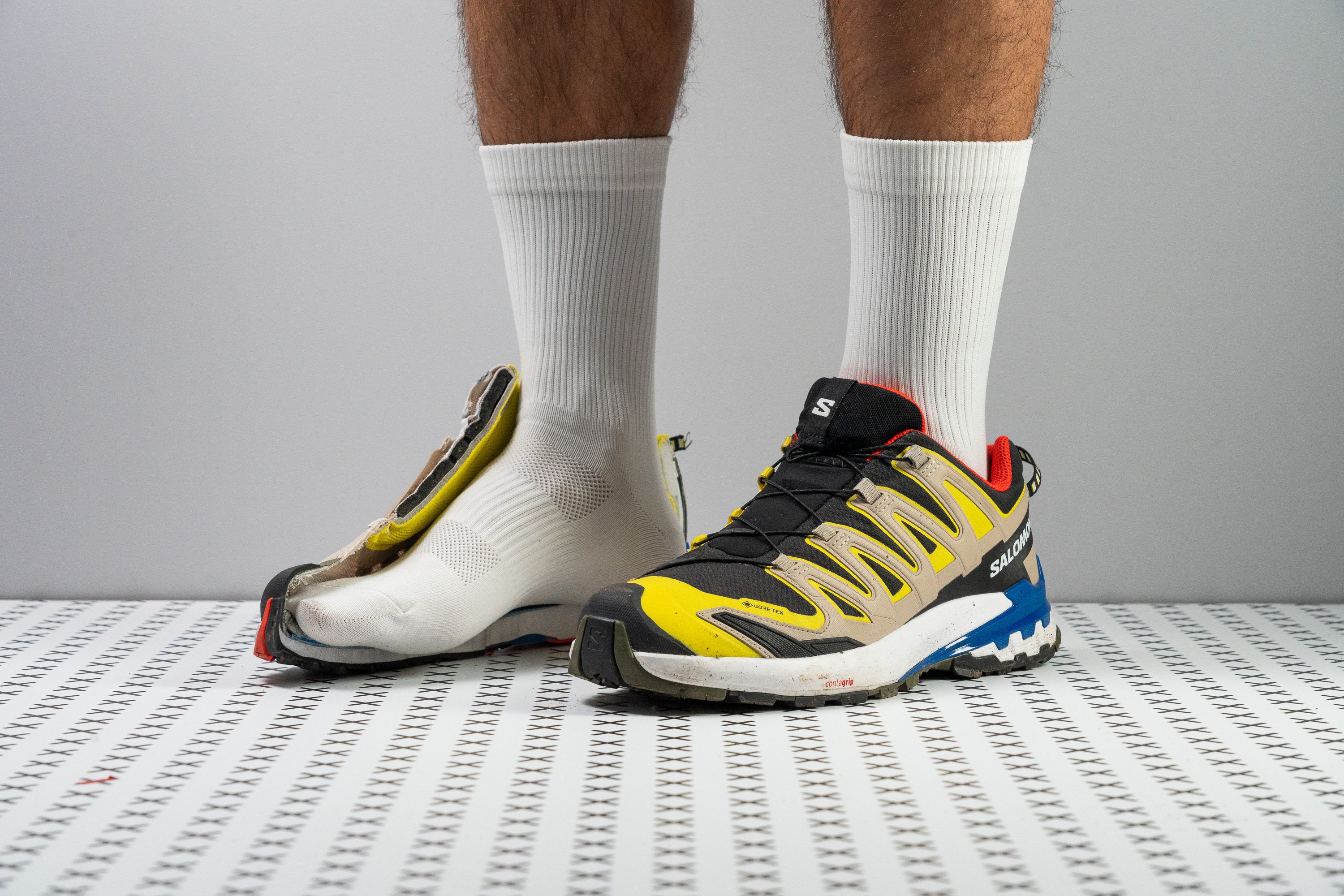













































What makes it the best?
The Salomon XA Pro 3D v9 GTX is heavy on top-to-bottom protection, while staying light on the feet. Post-testing in the lab, we discovered it offers the best stability in the lightweight waterproof hiking category through its 3D Chassis and dependable traction.
Starting with its main stabilizing component, the 3D Chassis offers strong side-to-side containment. It supports our feet well and effectively reduces fatigue since we don’t need to exert much effort to stay balanced inside the shoe. Our manual assessment verifies its twist-proof construction with the maximum 5/5 torsional rigidity rating. The Contagrip outsole also helps maintain steady footing, with its 2.8 mm sticky lugs delivering reliable grip.
The upper features Gore-Tex membrane, which effectively blocks off water, air, and other elements. In our smoke test, we couldn’t give it anything above the minimum 1/5 breathability score.
Despite all its layers of protection, the shoe weighs 12.7 oz (359g). Being 5.5% lighter than average, it feels effortless to walk long hours in this shoe.
However, its focus on support compromised the shoe’s flexibility. Those seeking a natural underfoot sensation should go for more forgiving shoes.
Pros
- Incredibly protective
- Extremely stable and supportive
- Watertight Gore-Tex upper
- Flexible and forgiving on the foot
- Makes a great hiking companion
- Effectively dampens landings
- Generously padded from heel to tongue
- No lace bite whatsoever
- Durable, high-quality construction
- Simple yet snazzy design
Cons
- Could be lighter
- Rather firm cushioning
- Upper needs breaking in
- Lacks the agility for technical trails
Best lightweight waterproof hiking shoes for technical terrain
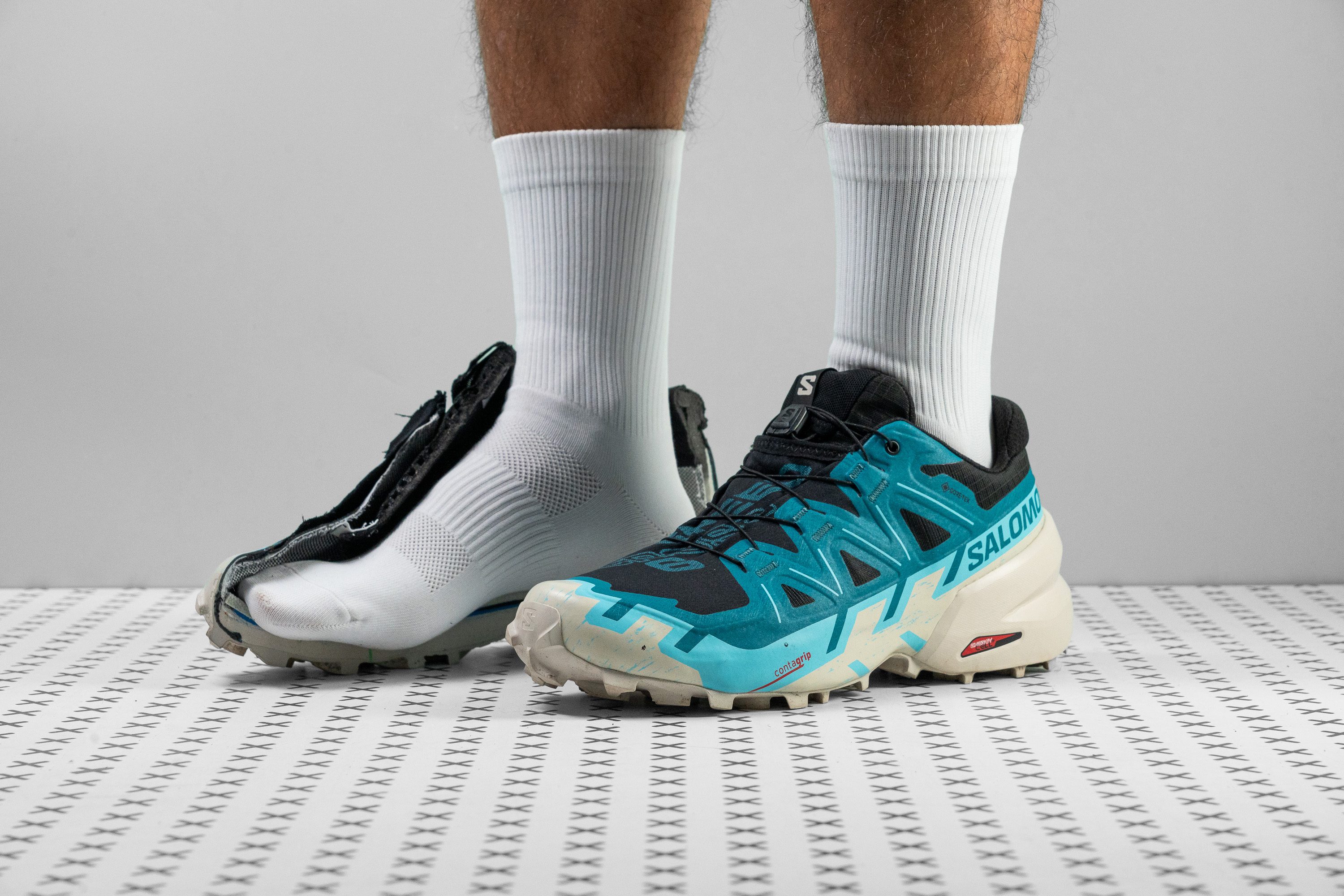
















































What makes it the best?
Salomon Speedcross 6 GTX is an agile performer that thrives in cold, wet, and challenging settings, handling various surfaces and conditions effortlessly. It’s our top technical terrain shoe in the lightweight waterproof hiking category because it carries us through slick surfaces with its reliable traction, homey feel, and light build.
Safety should always be a priority, especially in slippery or muddy trails. We felt secure in this pair since it features deep chevron-shaped 5.0 mm lugs, which act like brakes on inclined segments. It displays its adhesive power consistently during our treks.
With Gore-Tex and compact mesh in the upper, airflow is almost completely blocked, evidenced by our smoke test. With its 1/5 breathability score, it’s highly ideal for rainy or snowy runs. Our feet remained dry and toasty, leaving us with no excuses to skip our outdoor sessions.
With all the protection it offers, it only weighs 11.5 oz (325g). Being 14.5% lighter than the average hiking shoe, it made us feel more comfortable and versatile.
However, the midsole is firm, which may feel uncomfortable over long distances. Hikers seeking plush protection should go for another pair instead.
Pros
- Fully functional Gore-Tex membrane
- Ample cushioning for long adventures
- Excels in challenging, technical terrain
- Rapidly sheds mud
- Agile and tenacious grip on twisted trails
- Remarkable durability
- Ideal for heel strikers
Cons
- Completely lacks breathability
- Midsole could feel overly firm for some
- Exceptionally heavy
- Narrow, snug-fitting toebox
Yes, they really exist: lightweight waterproof hiking shoes
If you’re here, you’re into something very specific. First, not any hiking shoes but waterproof. Second, not just waterproof but also lightweight. What does it mean?
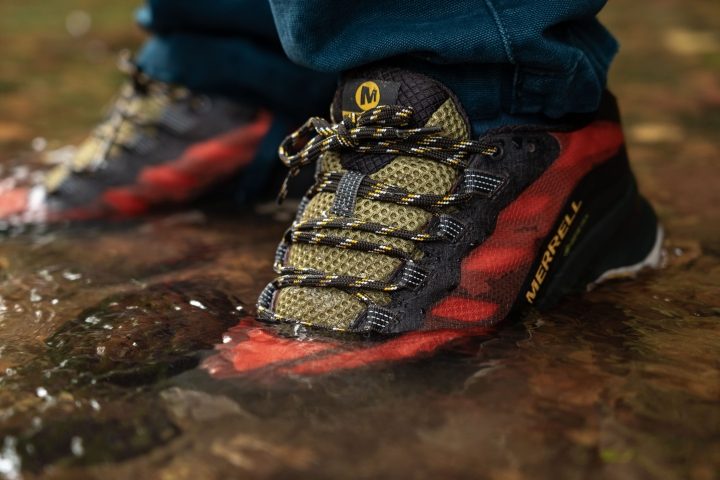
It means that these shoes are:
- Waterproof, obviously
- Lightweight, which means they are great for speed hiking and not just day hiking. It also means that they can make your feet feel less tired because they don’t feel bottom-heavy.
In our database, we consider hiking shoes lightweight when they weigh less than 14.1oz or 400g. With that in mind, here are the best-rated waterproof lightweight hiking shoes:
To get a clear picture why this group of shoes is so specific, let’s look at the average weights of other groups (at the moment of writing this review, March 2024):
- Average weight of all hiking shoes: 13.3 oz | 377.6g
- Average weight of lightweight hiking shoes: 11.7 oz | 332.7g
- Average weight of all waterproof hiking shoes: 14.3 oz | 406.9g
- Average weight of lightweight waterproof hiking shoes: 12.8 oz | 362.8g
Why you should trust us with these measurements? We buy all the shoes in men’s US 9 and weigh them on the same scale.
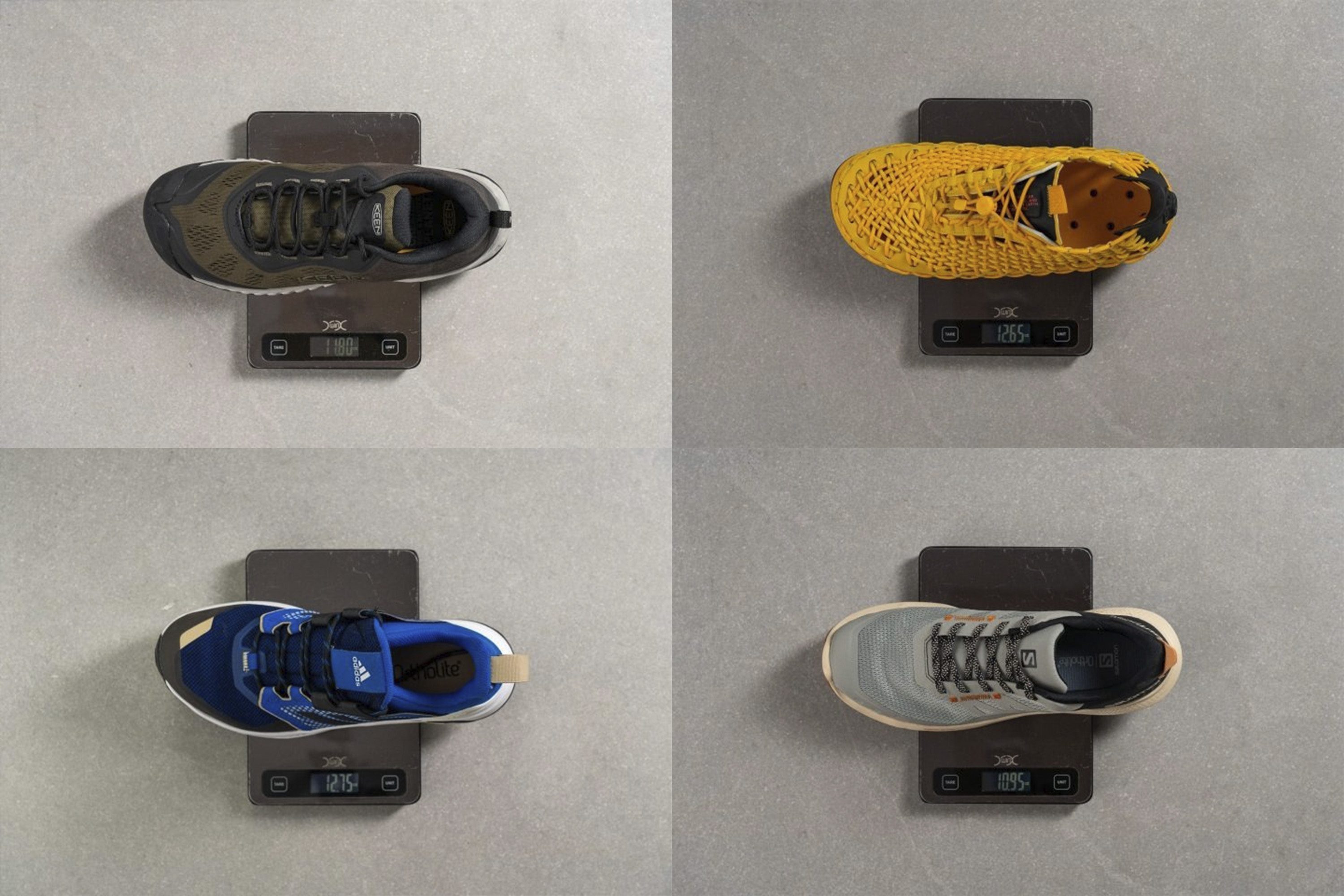
We also thoroughly test the shoes on our test hikes which involve puddles, rain, wet ground, and streams.
Basically, everything that is needed to properly test a waterproof hiking shoe.
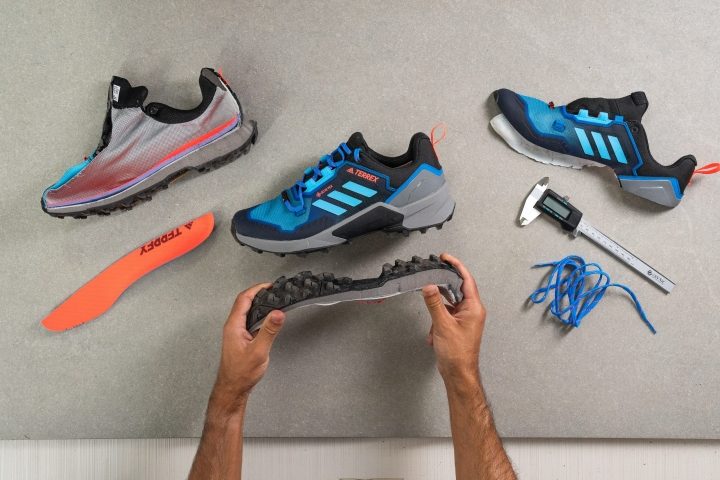
How to spot waterproof hiking shoes
The most popular waterproof membrane used in hiking shoes and hiking apparel is Gore-Tex. It’s easy to spot on hiking shoes because the logo is always included on the upper.
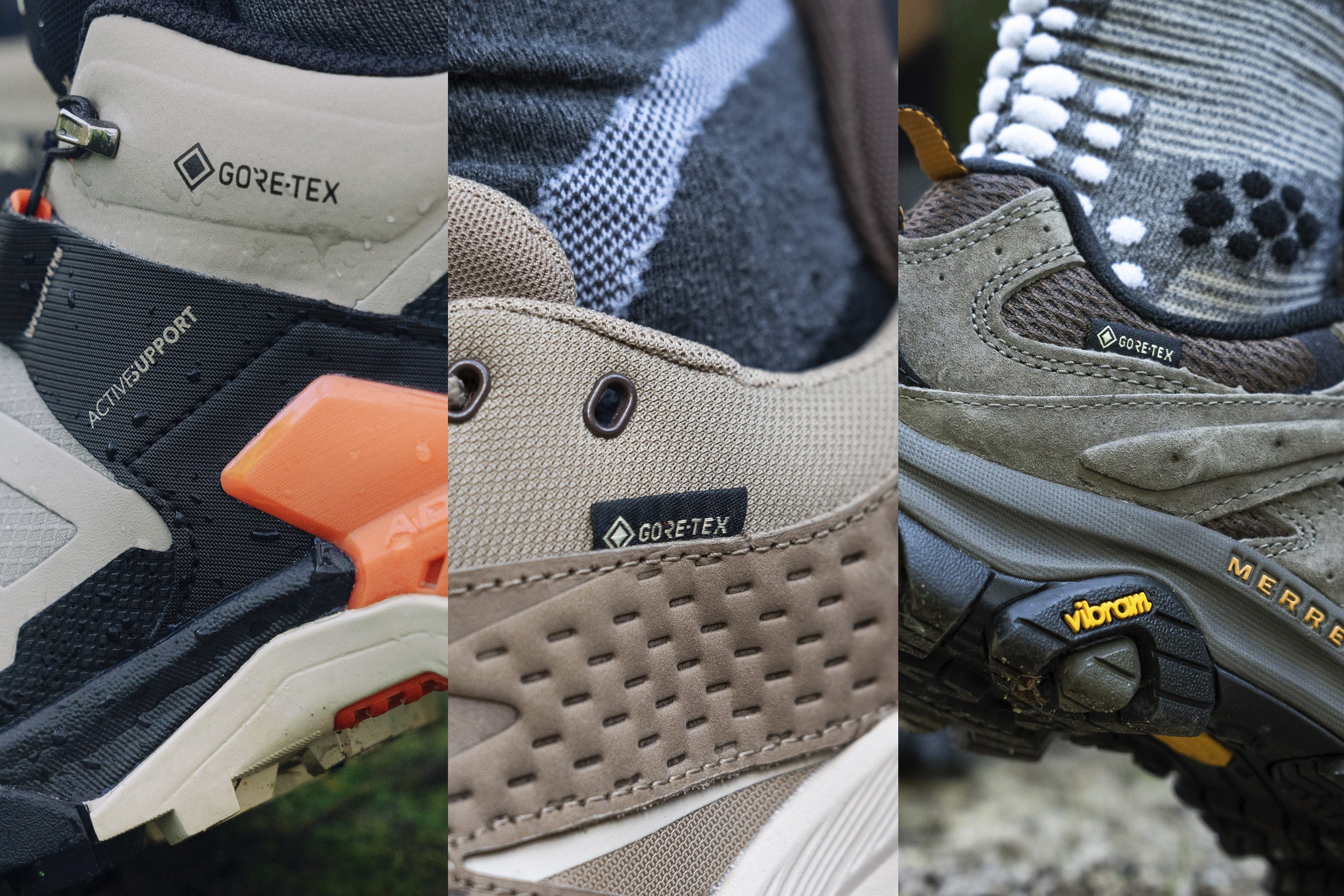
Of course, that’s not the only waterproof material on the market and many brands go on to develop and trademark their own waterproof technologies. Still, it is easy to spot as the shoe name, shoe box, and/or the shoe upper clearly specify it is the waterproof hiking shoe.
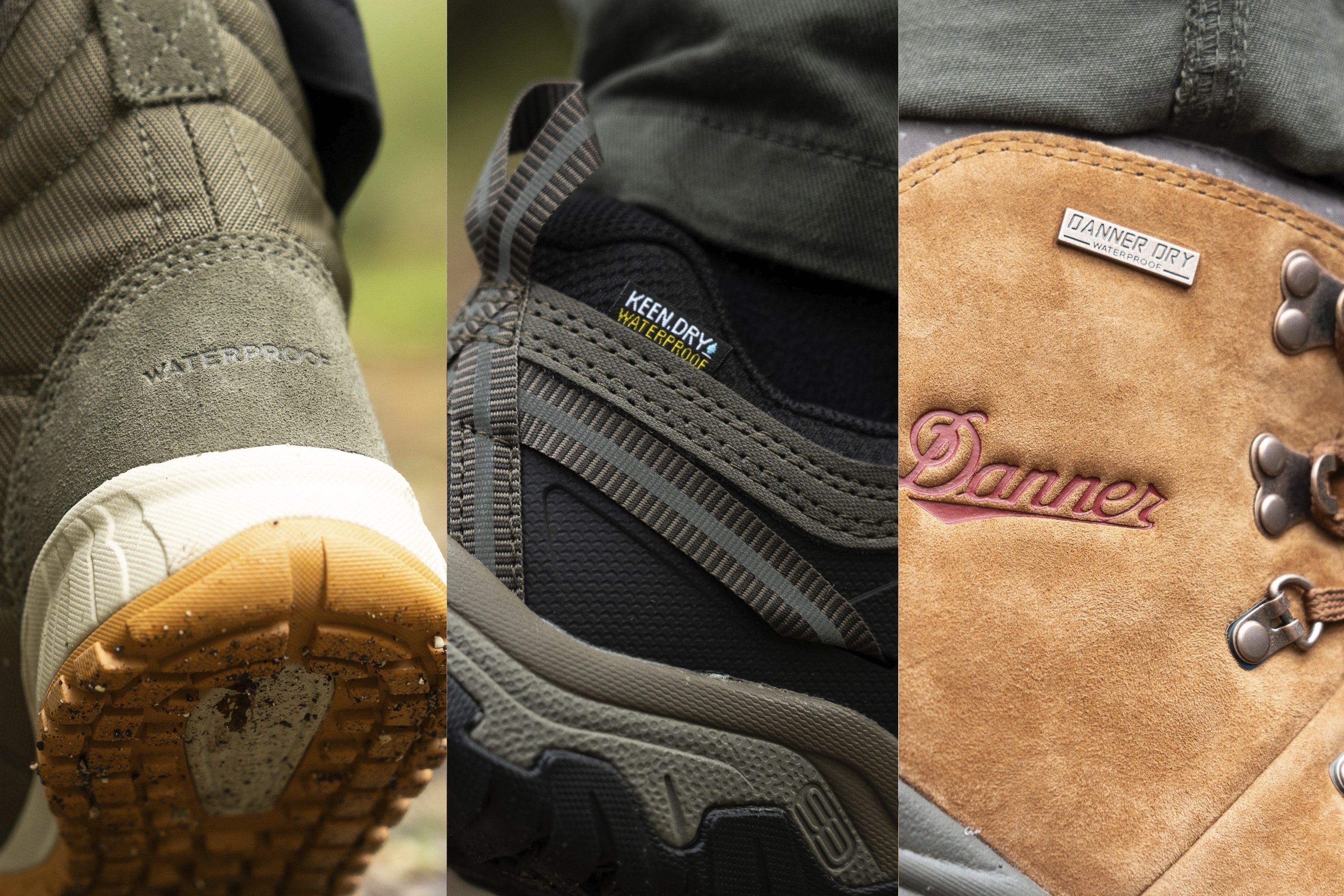
Levels of waterproofness: what you should now
First, it’s important to understand that in the world of waterproof hiking shoes, you should not settle for water-repellent or water-resistant. Here’s what to expect when comparing the 3:
| Water-resistant | Water-repellent | Waterproof | |
| General characteristics | a tightly woven fabric that is naturally capable of resisting water upon contact | fabric treated with durable water-repellent (DWR) or hydrophobic chemicals | - fabric treated with DWR - have waterproofing membranes like Gore-Tex and OutDry - have seam-sealed construction for extra protection |
| Water protection level | low water protection | moderate water protection | high water protection |
| Water pressure resistance | 0-5000 mm (no pressure or moisture) | 6000-10000 mm (light pressure) | 10000-20000 mm (high to very high pressure) |
| Weather conditions best used in | light rain shower and dry snow | light rain and average snow | moderate to heavy rain and average to wet snow |
With that behind us, let’s dive into the different levels of waterproofness. The measure we’re interested in is called hydrostatic head. It is measured in millimeters and it basically tells us how much water (in millimeters) we can pour into the 1’’x1’’ tube that’s placed over a piece of material before any leakage through the material happens.
Now, it’s easy to understand the specifications that come with waterproof membranes:
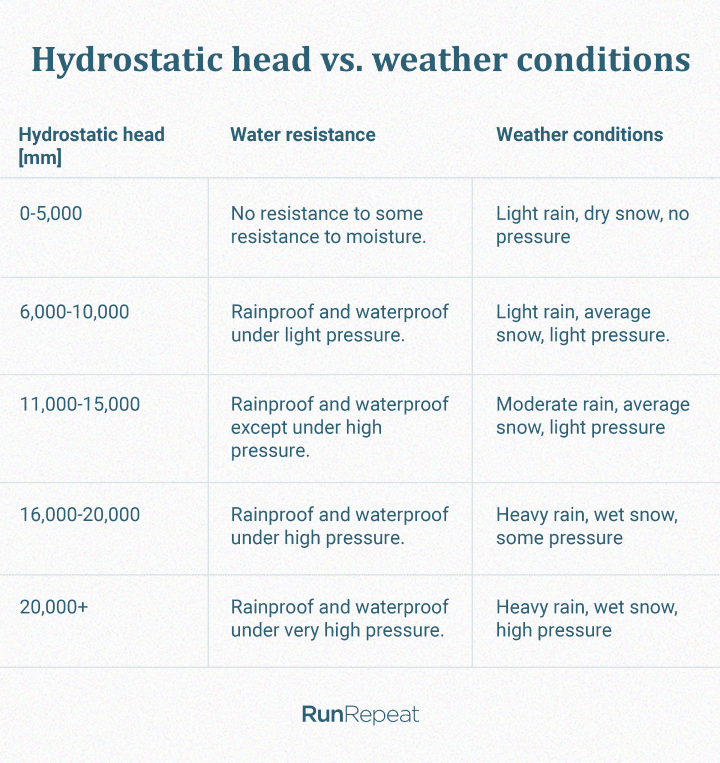
Beware: Waterproof means not breathable
Even though the manufacturer of Gore-Tex claims the membrane is breathable, after all the wear tests and lab tests, we’ve come to the conclusion that it’s not.
We examine every upper under the microscope. And here’s what non-waterproof uppers look like vs. waterproof ones. Waterproof ones have a very tight structure and fibers are overlapping. Non-waterproof uppers are more loose and, even when they don’t have literal ventilation holes, the air passes through.
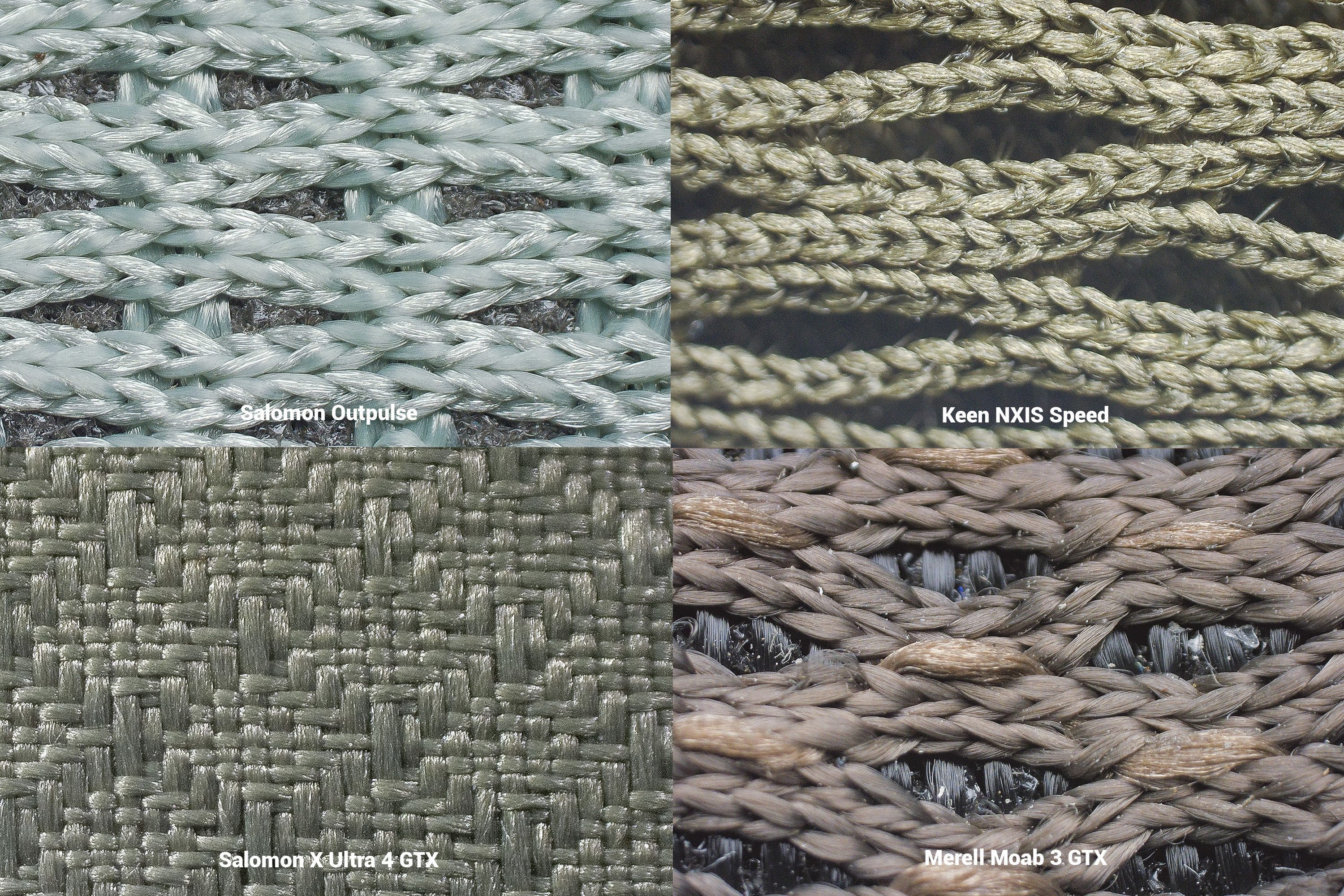
Once we've cut the shoe in half, we're able to examine everything in great detail. Here, it's easy to see the Gore-Tex fabric (white one) that is usually laminated to the "main" upper material (leather, suede, mesh):
In our lab, we also have a smoke machine that we use to pump the smoke into the shoe and analyze where the smoke comes out and at which pace. Based on what we see, we assign a rating of 1-5 for breathability to each shoe. 1 for the least breathable, 5 for the most breathable.
Sometimes, some smoke is able to pass through and then we’re able to rate the shoe with ⅖ for breathability.
Nail the grip you need for the hike
Waterproof hiking shoes are needed for hiking in wet weather. That means that the surface gets slippery.
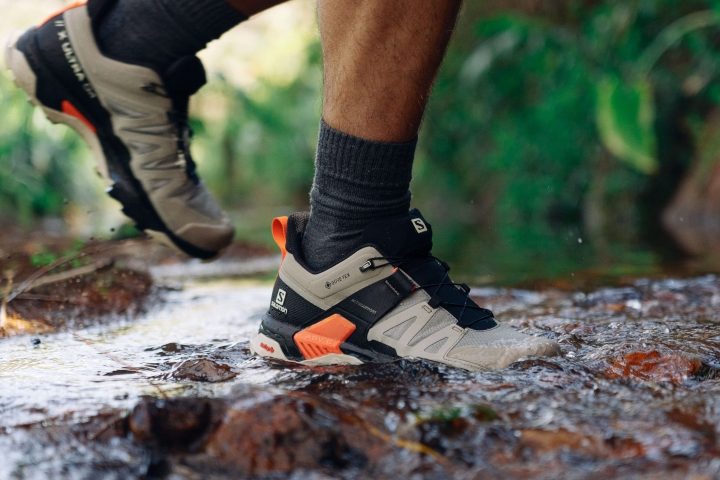
Here, we differentiate:
- Hard slippery surfaces, like rocks. We recommend around-the-average lugs here (~4 mm) and softer rubber. While it wears down sooner, especially when used on hard surfaces, it is usually stickier which is an imperative on wet slick surfaces.
- Soft wet surfaces, like slush, mud, snow. In this case, we recommend lugs that are at least 4 mm deep. Mud is a rather specific case where we recommend one more feature: lugs that are further apart from each other. This allows easier mud shedding.
When it comes to the grip, in our lab we perform 2 measurements. First, we measure the thickness of the lugs. We use a digital caliper to do this.
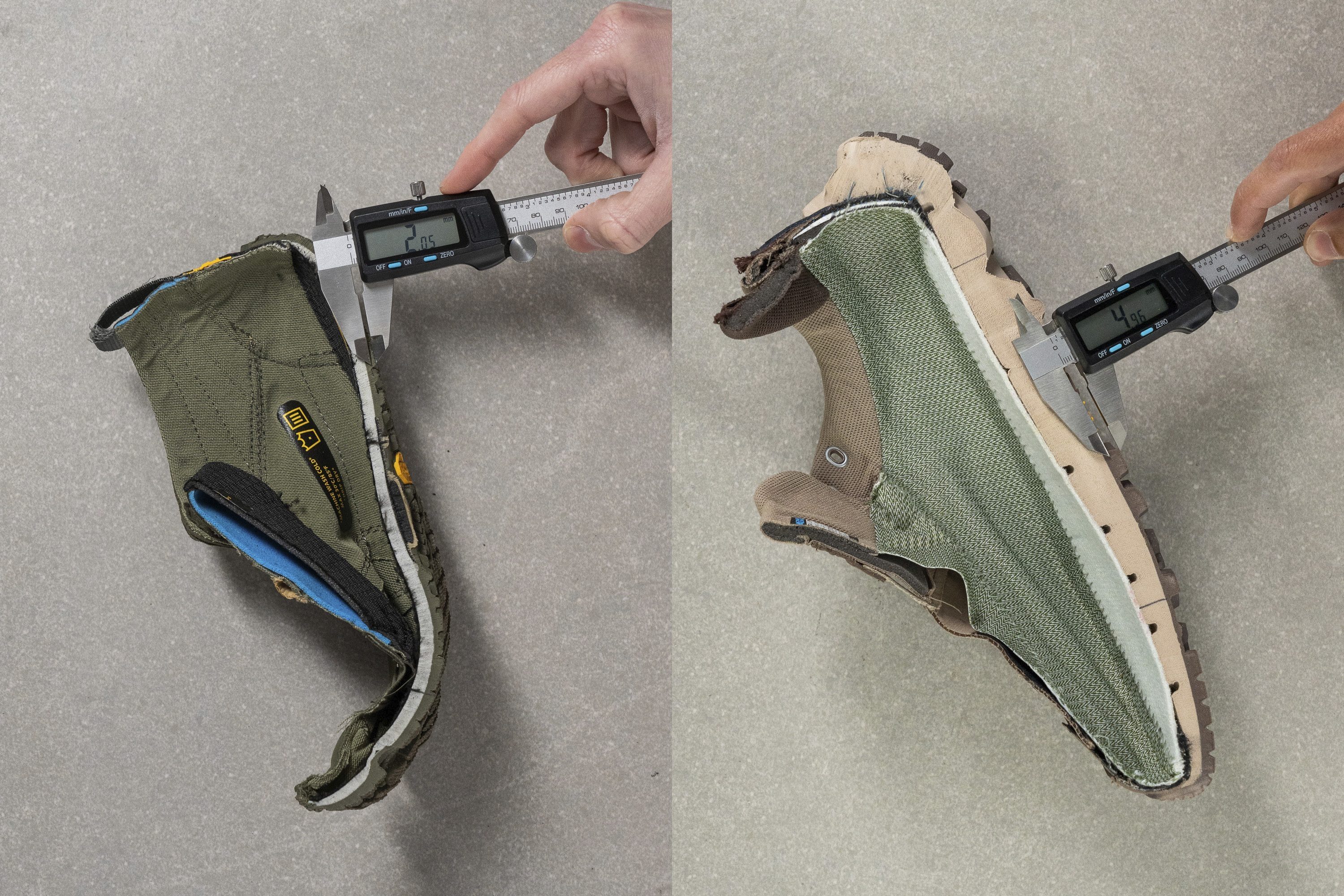
Then, we use a shore C durometer to measure the hardness of the outsole rubber. The result is always a number on a 0-100 scale and higher numbers mean harder rubber. Lower numbers, softer outsoles.
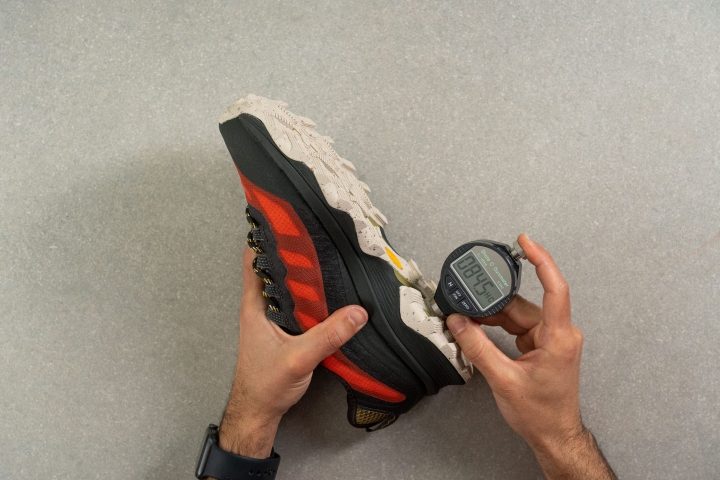
Equipped with these nuances, you can now have a look at lightweight waterproof hiking shoes that have deep lugs and softer outsoles.
Gusseted tongue: what is it and why you should look for it
Tongues can be free (not attached to the sides of the shoe), semi-free (semi-gusseted, attached to 1 side) and fully gusseted. Fully gusseted tongue is attached to both sides of the shoe, on the inside, just below the eyelets.
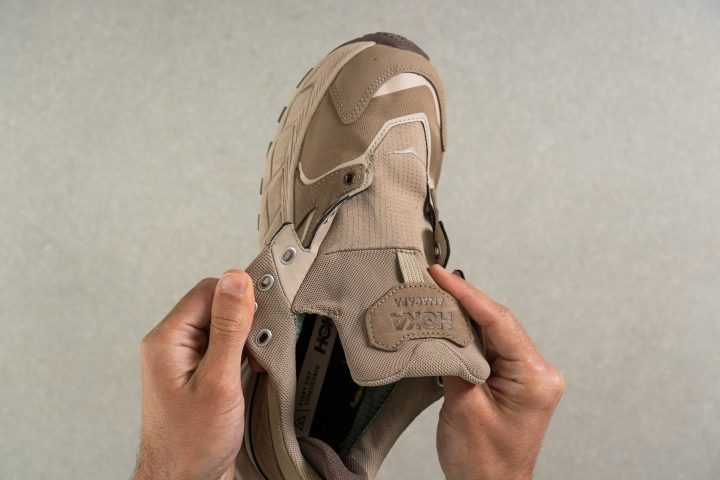
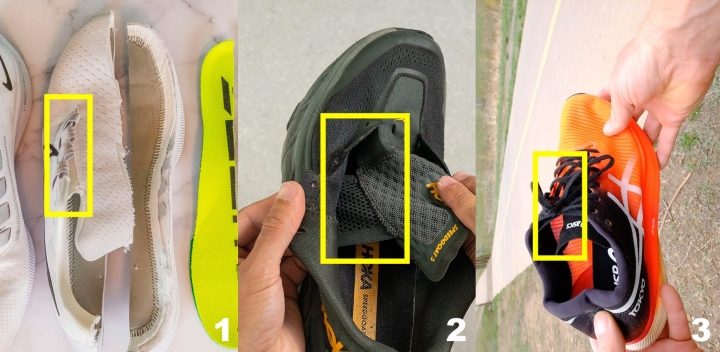
This type of tongue is the only one that helps keep water out because there’s that extra connection and material between the tongue and the sides. That’s why we always note down what type of tongue each hiking shoe has and you can find that in our reviews.
Water CAN still get inside your shoes
While the waterproof membranes are great at keeping the water outside, it still can end up in your shoes when:
- The water slides down your legs or trousers directly into your shoes
- You step into the water that is deeper than your shoes can protect you
When this happens, due to the non-breathability of waterproof shoes, there’s almost no way for the shoes, your feet, and socks to dry out on their own as you hike further. That can happen only if the rain has stopped and you have very breathable shoes (mesh upper).
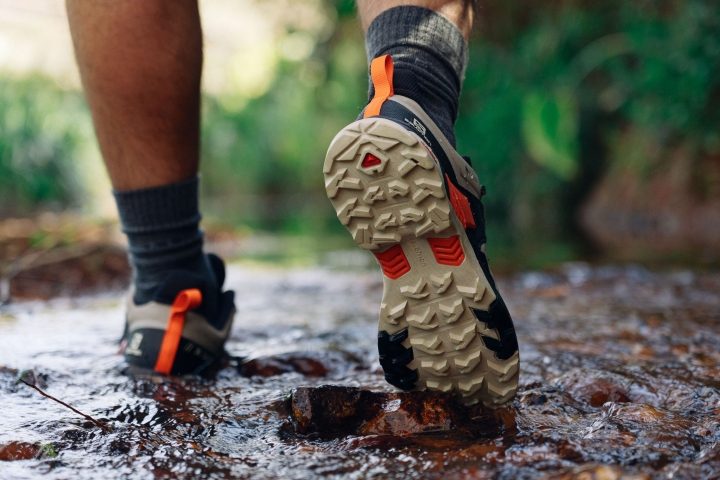
To prevent this from happening, consider getting waterproof (usually GTX) knee-high gaiters. They are great at keeping the water outside and it also means you get to wash them from the mud and dirt and not your trousers and socks as well.
Shock absorption of lightweight waterproof hiking shoes
Just because you're looking for lightweight footwear does not mean comfort and a protective ride should be sacrificed. For this reason, we shine light on the shock absorption.
Lab testing the shock absorption of lightweight waterproof hiking shoes
Hiking shoes with good (high) shock absorption protect hikers' feet from impact forces, while hiking shoes with bad shock absorption can cause foot pain and/or premature foot fatigue. This is why you may want to check the lab test results for the hiking shoe you are thinking of buying.
Durability of lightweight waterproof hiking shoes
Lightweight hiking shoes are usually associated with less rugged and, therefore, less durable hiking shoes. When it comes to waterproofing, it’s really important to have an upper that lasts and is not easily ripped apart.
When doing tests in our shoe lab, we test the durability of 3 shoe parts: toebox, outsole, and heel counter.
When testing the durability of the upper, we press our Dremel on the toebox and check the damage it has made. Then, we visually assess it and give it a 1-5 rating, where 1 is the least durable.
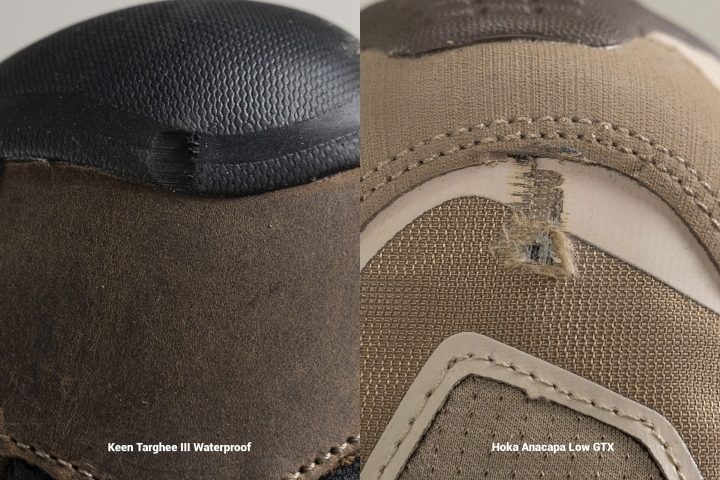
Then, we move on to the heel counter. Again, we use our Dremel and press it against the inner side. We do this to simulate what happens after a while because, for some hikers, this is the part that wears out the soonest. Again, we rate it on a 1-5 scale, with 5 being the most durable.
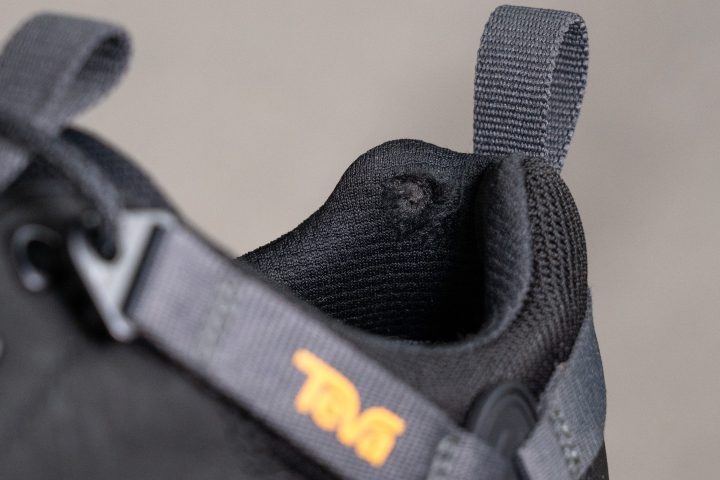
Last but not least, we press our Dremel against the outsole. Then, we use a digital tire tread depth gauge to measure the depth of the dent the Dremel has made. The deeper the dent (more millimeters), the less durable the outsole is. All these tests are standardized, meaning that we always apply the same force and do it in the same time intervals.

Stability is a priority in wet weather!
Stable hiking shoes tend to have a wide base. This means that the midsole is wider than the upper. Such hiking shoe construction allows for a secure, planted feel, which is a must in slippery terrain. High, narrow bases that make us feel wobbly in them are a no-go.
When it comes to lateral stability, we always test this when hiking and comment on it in our reviews.
Measuring the width of the base is something we do in our lab. With a caliper, we measure both the forefoot width and the heel width of the base of the hiking shoe. The wider the base, the more stable the shoe feels.
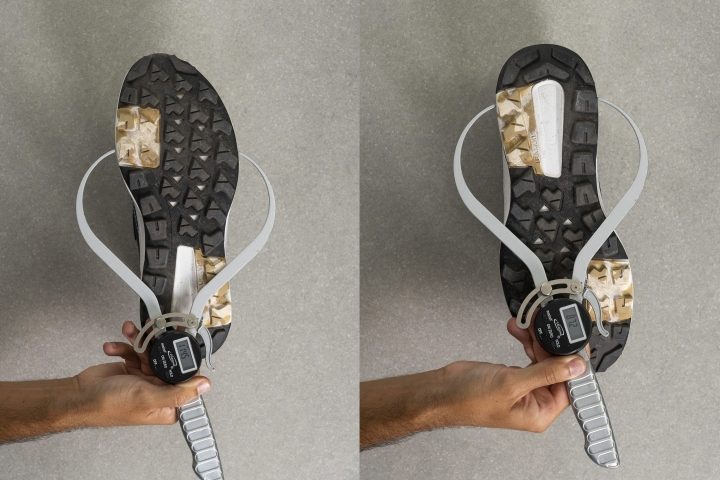
Here, we prioritize the width at the heel because it is where we first land while hiking (unlike running, where runners who land on the forefoot would prioritize that part of the shoe).
How to make sure that your hiking shoe fits right
This section usually comes at the top of the guide but when things get as specific as a) lightweight b) waterproof hiking shoes, you might already be very familiar with finding the right fit in hiking shoes.
Just in case, here’s a reminder on how to go about it:
- Best to go shoe shopping in the afternoon or in the evening. It’s when our feet swell a bit, and swelling happens on the hikes as well, so best to match that condition.
- Try the new hiking shoes in the hiking socks you usually use. The same goes for orthotics. Don’t forget to bring them with you.
- Once the shoe is on and laced up, sense if there are any hot spots. We’re aiming for the perfect fit, and hikers love being able to stuff a thumb behind the back of the heel.
- Walk up and down the ramp. Most specialized outdoor shops have it. They can also be covered with different materials: artificial grass, huge rocks, etc. Test the shoes on them all. There should be no foot sliding inside the shoes or heel slipping.
And finally, keep in mind that some hiking shoes need to be broken in. Do it gradually.

